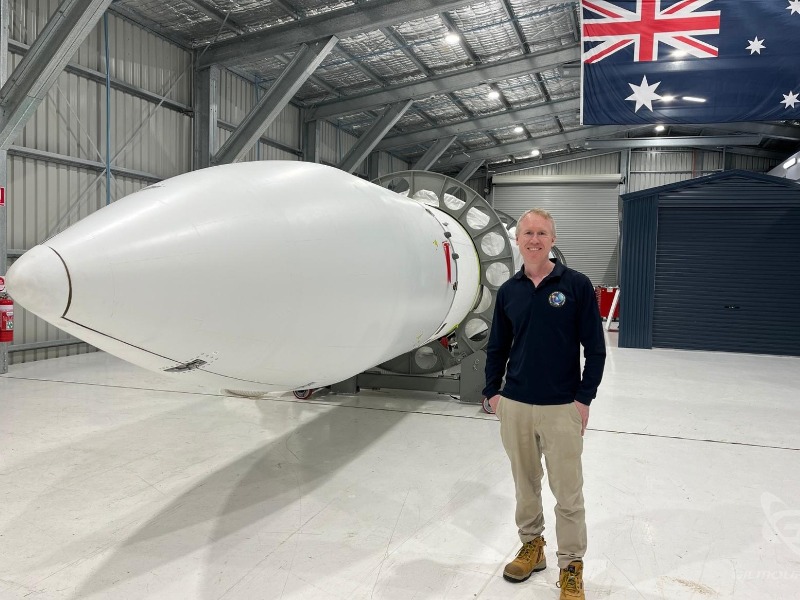The past two weeks have been massive in Gilmour Space Technologies’ build-up to the maiden flight of its Eris orbital vehicle, with the three-stage rocket now fully-integrated and ready for testing at the company’s Bowen Orbital Spaceport (BOS).
The first-time integration of the Eris vehicle is a huge moment for Gilmour Space and coincided with the announcement of a successful $55 million Series D capital raise, putting a $605 million valuation on the company.
While the fresh capital might give the company the extra comfort, it is the integration of the rocket that has the company buzzing, having worked deep into the night on a Friday ten days ago, to have Eris fully integrated inside the vehicle assembly building at Bowen ahead of the Series D announcement.
“We just thought that was just a huge statement to say that ‘here, we have completed Australia’s first orbital rocket, and here is a Series D [round] that’s going to ensure that we get safely up to orbit and into commercial operations’,” said Gilmour Space Technologies’ director of communications Michelle Gilmour.

The integration of the Eris vehicle is the culmination of years of work. But just the integration of the three stages as they were send up to Bowen from the company’s Gold Coast manufacturing facility was a solid two months of work.
The stage one of Eris is powered by four Gilmour-designed hybrid rocket engines called Sirius, which uses a liquid oxidiser mixed with a proprietary solid fuel. Stage two of the vehicle is powered by a single Sirius engine.
The final stage three is powered by a 3D-printed liquid rocket engine – also designed in-house by Gilmour – to take the vehicle the final distance to low-earth orbit. Both the Sirius and Pheonix engines completed final their final qualification test-fires in 2022.
With the three stages fully integrated, the company is settling into a period of final qualification, acceptance and testing – of everything from the vehicle itself, to the launch systems, the hold-down and launch release systems, the transport-erector.
So what has been happening in the past two weeks outside of the vehicle assembly building?
“We did the final installation of the hold-down table to the transporter erector. We did the final installation, and acceptance testing of the ground flight safety systems,” Ms Gilmour said.
“We did some launch rehearsals from the launch control via remote connection, and actually did operate the launch vehicle within the Vehicle Assembly Building remotely. So that’s part of the testing,” she said.
“We built up our propellant storage and filling system because that’s part of the fluid systems [for the project].
“And then of course we have been working really, really hard to get the launch approvals across line.”
Gilmour says it will intends to launch in early to mid-April. There is still a ton of work to get through.
In the next two weeks, what does the work program look like?
“We will be commissioning the ground launch system, connecting it to the rockets [and to] the fluid system.,” Michelle Gilmour said. And we will be fine tuning our launch procedures now that the rocket is connected to the ground support equipment.
“We’re going to be doing end to end testing of our flight safety systems. And if things go well, we’re going to be starting on our dry dress rehearsal, which is basically going through the whole launch procedure without the fluids,” she said.
All of this means, in the next couple of weeks, it’s possible the rocket will be moved to a vertical position for the first time.
Ms Gilmour said there remains a huge amount of work to get through. The company is committed to flying Eris in early April. But there remains a full schedule of wet testing.
But moving the rocket to vertical will be a huge milestone, both in terms of the number of systems that have been tested and accepted to enable this, and the number of testing procedures that the vertical rocket will enable.
There are still some licences and permits that still need sign-off. These are clearly a focus for the company.
For now, the Gilmour Space Technologies staff are still buzzing about the integration of the Eris rocket. It’s a very big moment for the company, and there is a lot of excitement about its future.
“The first stage has four engines in it, it’s the main engine that carries the whole rocket off the ground and accelerates toward space,” Michelle Gilmour said.
“And then when that falls off, the second stage actually fires up and carries the second and third stage onwards and accelerates even more. And then finally the third stage fires up and takes the payload to space,” she said.
The company has always been realistic about the prospects of reaching orbit on its first flight. There has never been a newly-designed launch vehicle that has made orbit on its first attempt. Even SpaceX’s Falcon1 did not reach orbit until its fourth flight.
Do you know more? Contact James Riley via Email.

